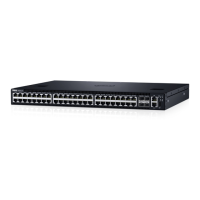Stacking
Using the Dell Networking OS stacking feature, you can interconnect multiple switch units with stacking ports or front end user ports. The
stack becomes manageable as a single switch through the stack management unit.
The system accepts Unit ID numbers from 1 to 6 and it supports stacking up to six units.
Topics:
• Stacking Overview
• Important Points to Remember
• Stacking Installation Tasks
• Stacking Conguration Tasks
• Verify a Stack Conguration
• Remove Units or Front End Ports from a Stack
• Troubleshoot a Stack
Stacking Overview
Dell Networking OS elects a management (master) unit, a standby unit, and all other units are member units.
Dell Networking OS presents all of the units. For example, to access GigabitEthernet Port 1 on Stack Unit 1, enter interface
tengigabitethernet 1/1
from CONFIGURATION mode.
Stack Management Roles
The stack elects the management units for the stack management.
• Stack master — primary management unit, also called the master unit.
• Standby — secondary management unit.
• Stack units — the remaining units in the stack, also called stack members. The system supports up to six stack units.
The master holds the control plane and the other units maintain a local copy of the forwarding databases. From the stack master you can
congure:
• System-level features that apply to all stack members.
• Interface-level features for each stack member.
The master synchronizes the following information with the standby unit:
• Stack unit topology
• Stack running conguration (which includes ACL, LACP, STP, SPAN, and so on.)
• Logs.
The master switch maintains stack operation with minimal impact in the event of:
• Switch failure
48
800 Stacking

